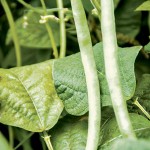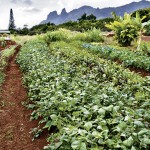The Biodynamic Farming Spirit
Marie Mauger established Spirit of the Earth Farm in 1999. The biodynamic farm grows 120 items, some of which are listed below, on 16.48 acres. One of the first modern ecological farming systems, biodynamic agriculture is a method of organic farming that emphasizes the holistic development and interrelationships of soil, plants and animals as a self-sustaining system.
The nonprofit farm focuses on research and education. In 2006, Mauger published a study in a quarterly journal for the Biodynamic Farming and Gardening Association. “Safe Food From Contaminated Soil?” was based on a study Mauger did to clean up DDT found in Moloa’a soil. DDT is an insecticide that was used extensively until 1962, when American biologist Rachel Carson wrote in Silent Spring about the detrimental impacts to human and environmental health. DDT was banned in the U.S. in 1972.
Mauger has been invited to speak at the 2012 North American Biodynamic Conference in Madison, Wis., next month. “Our mission is love and care of earth and all life through sustainable biodynamic food production for local consumption,” she says.
What’s growing now: Amaranth, asparagus, arugula, avocado, banana, basil, beans, breadfruit, broccoli, beets, buckwheat, cabbage, carrots, celery, chia, chicory, cilantro, citrus, coco yam, collards, cucumber, dandelion, dill, dragon fruit, esca-role, eggplant, fennel, galangal, ginger, horseradish, jicama, kale, lettuce, peppers, potatoes, radicchio, squash, taro, tomatoes, turmeric, yacon, zucchini.
GREEN BEANS
There are more than 130 varieties of green beans, and are either bush or pole beans. Pole beans have a climbing habit and produce a twisting vine. Bush beans grow on short plants to about 2 feet in height.
Of the many types of beans we consume, few are eaten fresh. Green beans are picked at an immature stage, when the inner seed (bean) has just started to form. If left on the plant, the seeds eventually grow to full size and dry in the pod.
Immature pods contain a good amount of beta-carotene and vitamin C. Dried beans are high in protein and carbohydrates. Fresh beans are classified into two categories: those with edible pods and those that are shelled.
Season: On Kaua’i, green beans can grow year-round, and take 12 weeks to mature.
What to look for: Lively, tender pods that have good color, are free of rusty spots, are stiff rather than flaccid and small rather than large – they should be no thicker than a pencil. Green beans, also known as snap beans, should snap crisply when broken.
Storage: They are best eaten right away, but will store in a plastic bag in the refrigerator for up to a week.
Preparation: Cooked beans are snappy additions to salads, side dishes, soups, stews and stir-fries. Japanese restaurants serve green bean tempura. Green beans can be steamed, blanched or sautéed. I like to roast them with olive oil, salt and pepper, as their flavor becomes concentrated and the beans get caramelized.
Green beans pair well with olive oil, walnut oil, butter, crème fraiche, dark sesame and roasted peanut oils, basil, parsley, dill, tarragon, ginger, shallots, garlic, tomatoes, olives and capers.
Green beans are most popular in the United States when families make green bean casserole for Thanksgiving, which is made with cream of mushroom soup and fried onions.
Tip: Boil beans in salted water, uncovered, for about three minutes. Covering the pan causes the beans to turn gray. If adding to a salad, stop cooking and brighten color by putting beans in a bowl with ice water.
Health benefits: Recent studies have confirmed the presence of several anti-inflammatory carotenoids in green beans including lutein, beta-carotene, violaxanthin and neoxanthin. Research comparing the overall antioxidant capacity of green beans to other foods in the pea and bean families (for example, snow peas or wing beans) has found green beans to come out on top. They also are a good source of absorbable silicon, which improves skin, hair, nails and joint mobility.
Spirit of the Earth Farm produce can be found at: Farmers Markets: Kapa’a (Wednesdays 3 p.m.), and Hanalei (Saturdays 9:30 a.m.) Restaurants: Lemongrass, The Garden Cafe, Art Cafe Hemingway, Verde. Grocery: Hoku Foods, Papaya’s Natural Foods and Cafe, Harvest Market, Healthy Hut. There is also a Community Supported Agriculture (CSA) program available. For more information, call 822-7899 or email mariemauger@yahoo.com.
MOM’S GREEN BEANS
Growing up, my mom would make this when she had an especially abundant crop of green beans in her home garden. Crisp bacon, soft onions and creamy potatoes make this a comforting side dish.
* 6 strips bacon, diced
* 2 medium-size gold potatoes, cubed
* 1 large onion, diced
* 1 pound green beans, stem ends removed
* extra virgin olive oil
Put diced bacon in a medium-sized pot and cook over medium heat until crisp. Remove pan from heat and spoon bacon onto a paper towel, making sure to leave 1 tablespoon of bacon fat in pan.
Add diced onion to pot with a large pinch of salt and pepper. Cook until softened, about seven minutes. Add potatoes and 2 cups of water, bring to a boil and reduce to a simmer. Cook 10 minutes, until potatoes are almost done.
Add green beans and simmer for three minutes, until beans are soft but still crisp. Stir in bacon and serve with a slotted spoon. Finish with a drizzle of extra virgin olive oil and a sprinkling of Hawaiian sea salt. Makes four servings.
Marta Lane is a Kaua’i-based food writer. For more information, visit TastingKauai.com.
- Samantia Renee harvests at Spirit of the Earth Farm
- Look for Nils Anderson at the farmers market. Daniel Lane photos
- Bush bean pods
- Bush beans grow on short plants to about 2 feet in height. Daniel Lane photos
- Marie Mauger doesn’t let age or a walking disability keep her from farming








